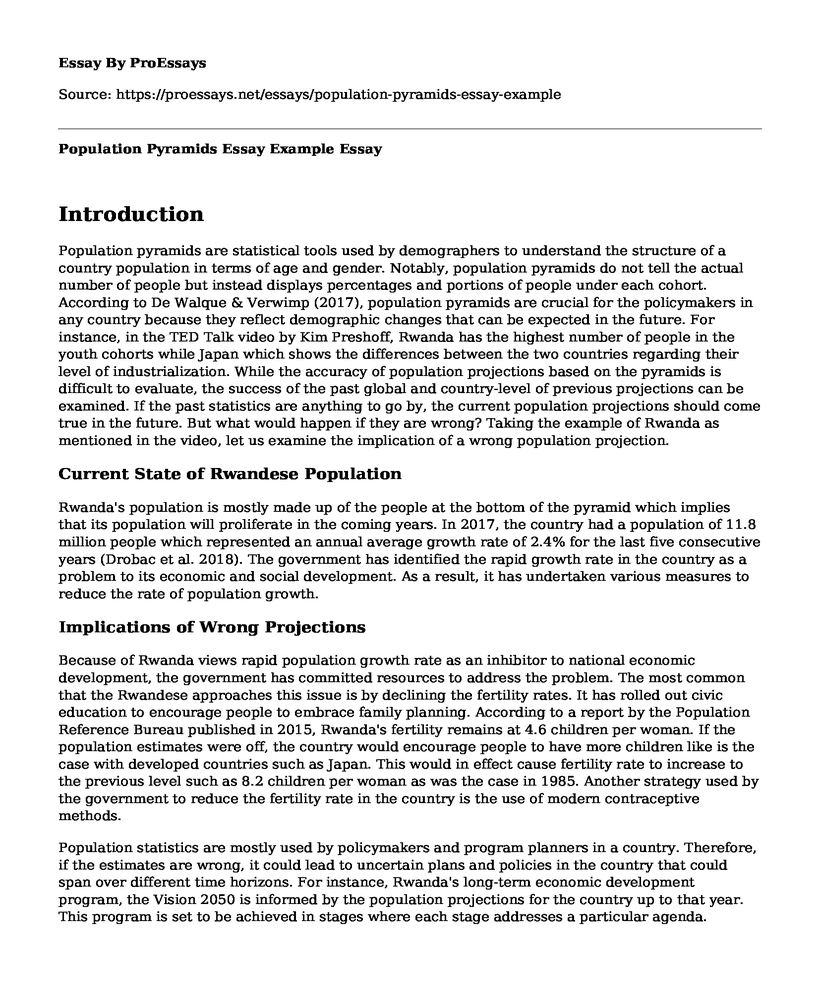Introduction
Population pyramids are statistical tools used by demographers to understand the structure of a country population in terms of age and gender. Notably, population pyramids do not tell the actual number of people but instead displays percentages and portions of people under each cohort. According to De Walque & Verwimp (2017), population pyramids are crucial for the policymakers in any country because they reflect demographic changes that can be expected in the future. For instance, in the TED Talk video by Kim Preshoff, Rwanda has the highest number of people in the youth cohorts while Japan which shows the differences between the two countries regarding their level of industrialization. While the accuracy of population projections based on the pyramids is difficult to evaluate, the success of the past global and country-level of previous projections can be examined. If the past statistics are anything to go by, the current population projections should come true in the future. But what would happen if they are wrong? Taking the example of Rwanda as mentioned in the video, let us examine the implication of a wrong population projection.
Current State of Rwandese Population
Rwanda's population is mostly made up of the people at the bottom of the pyramid which implies that its population will proliferate in the coming years. In 2017, the country had a population of 11.8 million people which represented an annual average growth rate of 2.4% for the last five consecutive years (Drobac et al. 2018). The government has identified the rapid growth rate in the country as a problem to its economic and social development. As a result, it has undertaken various measures to reduce the rate of population growth.
Implications of Wrong Projections
Because of Rwanda views rapid population growth rate as an inhibitor to national economic development, the government has committed resources to address the problem. The most common that the Rwandese approaches this issue is by declining the fertility rates. It has rolled out civic education to encourage people to embrace family planning. According to a report by the Population Reference Bureau published in 2015, Rwanda's fertility remains at 4.6 children per woman. If the population estimates were off, the country would encourage people to have more children like is the case with developed countries such as Japan. This would in effect cause fertility rate to increase to the previous level such as 8.2 children per woman as was the case in 1985. Another strategy used by the government to reduce the fertility rate in the country is the use of modern contraceptive methods.
Population statistics are mostly used by policymakers and program planners in a country. Therefore, if the estimates are wrong, it could lead to uncertain plans and policies in the country that could span over different time horizons. For instance, Rwanda's long-term economic development program, the Vision 2050 is informed by the population projections for the country up to that year. This program is set to be achieved in stages where each stage addresses a particular agenda. Therefore, wrong estimates for population growth by 2050 would lead to ineffective policies and programs in solving the countries problems. Based on the current projections, Vision 2050 is meant to provide economic growth through the promotion of equitable and quality education, investment in job creation, health, and good governance (World Bank Group 2014).
Conclusion
Population statistics are crucial for individual countries and the world as a whole. It is for this reason that countries usually conduct a census at given intervals. Policymakers and program planners rely on the statistics to come up with policies and plans for social change. Therefore, they should cooperate with demographers to ensure accurate demographic data. This could be achieved by supporting organizations to research on better projection methodologies.
References
De Walque, D., & Verwimp, P. (2017). The demographic and socio-economic distribution of excess mortality during the 1994 genocide in Rwanda. Journal of African Economies, 19(2), 141-162. https://doi.org/10.1093/jae/ejp029
Drobac, P. C., Basinga, P., Condo, J., Farmer, P. E., Finnegan, K. E., Hamon, J. K., ... & Murangwa, Y. (2018). Comprehensive and integrated district health systems strengthening: The Rwanda Population Health Implementation and Training (PHIT) Partnership. BMC health services research, 13(2), S5. https://doi.org/10.1186/1472-6963-13-S2-S5
Population Reference Bureau, (2015). 2014 World Population Data Sheet, (Washington, DC: Population Reference Bureau. Retrieved from https://stage.prb.org/2014-world-population-data-sheet/
United Nations Population Division, (2015). World Population Prospects: The 2015 Revision, New York: United Nations.
World Bank Group. (2014) Worldwide Governance Indicators. Retrieved from http://info.worldbank.org/governance/wgi/index.aspx#home
Cite this page
Population Pyramids Essay Example. (2022, Nov 20). Retrieved from https://proessays.net/essays/population-pyramids-essay-example
If you are the original author of this essay and no longer wish to have it published on the ProEssays website, please click below to request its removal:
- Multivariate Analysis
- A Review of the European Communication Monitor (ECM) Report 2016 Paper Example
- Essay Sample on Intention and Desire
- Essay Sample on Mexican Folk Songs
- Essay on Social Support Theory: Understanding Traumatic Situations and Emotional Attachments
- Essay Example on the Magnetic Power of Jay: How He Easily Wooed Ladies
- Japan's Population Decline: A Worrying Trend in a Growing World - Essay Sample







